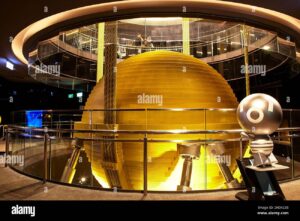Bitcoin Miner: Everything You Need to Know – In the world of cryptocurrency, Bitcoin holds a prominent position, and its creation process, known as Bitcoin mining, plays a vital role in the functioning of the network. This article will guide you through the fundamentals of Bitcoin mining, how it works, the equipment involved, mining profitability, environmental concerns, and more. So let’s dive in and explore the fascinating world of Bitcoin mining.
Bitcoin Miner: Everything You Need to Know / Bitcoin Miner: Everything You Need to Know / Bitcoin Miner: Everything You Need to Know / Bitcoin Miner: Everything You Need to Know
2. What is Bitcoin Mining?
Bitcoin mining is the process of validating and verifying transactions on the Bitcoin network, while also creating new Bitcoins. It is an integral part of the decentralized system that ensures the security, transparency, and integrity of the cryptocurrency. Miners use powerful computers to solve complex mathematical puzzles that validate transactions and add them to the blockchain, a public ledger containing all Bitcoin transactions.
3. How Does Bitcoin Mining Work?
Bitcoin mining operates on a concept called proof-of-work (PoW). Miners compete to solve a cryptographic puzzle by making numerous attempts using their computational power. The first miner to find the correct solution broadcasts it to the network, and other miners verify the validity of the solution. Once confirmed, the block is added to the blockchain, and the miner is rewarded with a certain amount of Bitcoins.
4. The Role of Miners in the Bitcoin Network
Miners play a crucial role in maintaining the integrity and security of the Bitcoin network. Their primary responsibilities include:
- Validating and verifying transactions
- Securing the network against potential attacks
- Adding new blocks to the blockchain
- Issuing new Bitcoins into circulation
Without miners, the Bitcoin network would be vulnerable to fraudulent activities and lack the necessary computational power to function effectively.
5. Types of Bitcoin Miners
There are two main types of Bitcoin miners:
a) ASIC Miners: Application-Specific Integrated Circuit (ASIC) miners are specialized devices designed solely for mining cryptocurrencies. These powerful machines offer high computational power and energy efficiency, making them the preferred choice for professional miners.
b) GPU Miners: Graphics Processing Units (GPUs) can also be used for Bitcoin mining. While GPUs are less specialized than ASIC miners, they provide a more affordable entry point for individuals interested in mining.
6. Mining Hardware and Equipment
To engage in Bitcoin mining, miners require specialized hardware and equipment. ASIC miners are the most common choice due to their efficiency, speed, and profitability. Notable ASIC manufacturers include Bitmain, Canaan Creative, and MicroBT. GPU miners, on the other hand, utilize high-performance graphics cards from companies like NVIDIA and AMD.
7. Setting Up a Bitcoin Mining Operation
Setting up a Bitcoin mining operation involves several essential steps:
a) Choosing the Right Location: Miners need to consider factors such as electricity costs, cooling requirements, and the legal and regulatory environment before selecting a suitable location for their mining operation.
b) Acquiring Mining Hardware: Miners must purchase or lease the necessary mining equipment, such as ASIC miners or GPUs, depending on their budget and mining goals.
c) Creating a Mining Rig: Miners assemble the mining hardware into a dedicated rig or use pre-built mining machines designed for optimal performance.
d) Setting Up a Wallet: Miners need a secure Bitcoin wallet to receive their mining rewards and store their Bitcoins.
8. Mining Pools and Cloud Mining
Due to the increasing difficulty of mining and the need for substantial computational power, many miners join mining pools. Mining pools allow multiple miners to combine their resources and work together to solve blocks. Once a block is successfully mined, the rewards are distributed among the pool members based on their contributed computational power.
Cloud mining is an alternative option where miners can rent mining hardware and computational power remotely from a provider. This eliminates the need for physical mining equipment but comes with associated risks and potential scams.
9. The Mining Process Explained
The Bitcoin mining process can be summarized as follows:
a) Miners receive a list of unconfirmed transactions from the Bitcoin network. b) They choose a set of transactions and include them in a block. c) Miners start solving the cryptographic puzzle by repeatedly hashing the block data until they find a solution that meets the specified criteria. d) The first miner to find a valid solution broadcasts it to the network. e) Other miners validate the solution and, if correct, add the block to the blockchain.
10. Bitcoin Mining Difficulty
Bitcoin mining difficulty is a measure of how hard it is to find a suitable solution to the cryptographic puzzle. The difficulty adjusts approximately every two weeks, aiming to maintain a consistent block generation time of around 10 minutes. As more miners join the network or new, more efficient mining hardware is introduced, the difficulty increases to maintain the desired block time.
11. Energy Consumption and Environmental Impact
Bitcoin mining is energy-intensive, and the environmental impact of mining has been a subject of debate. The energy consumption arises from the computational power required to solve the cryptographic puzzles. Miners are exploring renewable energy sources and more energy-efficient mining technologies to mitigate environmental concerns.
12. Mining Profitability and Rewards
Mining profitability depends on factors such as the cost of electricity, mining hardware efficiency, Bitcoin price, and mining difficulty. Miners need to consider these variables to determine their potential earnings. In addition to earning Bitcoins through block rewards, miners may also receive transaction fees associated with the transactions they include in the blocks.
13. Risks and Challenges of Bitcoin Mining
Bitcoin mining faces several risks and challenges:
- Volatility: Bitcoin’s price is highly volatile, which affects mining profitability.
- Competition: The increasing number of miners and mining pools makes it more challenging to mine new Bitcoins.
- Regulatory Changes: Regulatory changes can impact the legality and profitability of mining operations in different regions.
14. Future of Bitcoin Mining
The future of Bitcoin mining is marked by ongoing technological advancements, increasing adoption, and regulatory developments. As the industry evolves, miners will continue to seek innovative solutions to address scalability, energy efficiency, and environmental concerns. Additionally, the integration of mining with renewable energy sources may lead to a more sustainable and environmentally friendly mining ecosystem.
15. Conclusion
Bitcoin mining plays a crucial role in the operation and security of the Bitcoin network. It involves solving complex mathematical puzzles using specialized hardware and equipment to validate transactions and add them to the blockchain. While mining can be profitable, it requires careful consideration of factors such as electricity costs, mining difficulty, and environmental impact. As the industry evolves, miners will face both challenges and opportunities in shaping the future of Bitcoin mining.
FAQs
1. Can I mine Bitcoin with my regular computer?
- No, Bitcoin mining requires specialized hardware, such as ASIC miners or high-performance GPUs, to have a realistic chance of mining profitably.
2. How long does it take to mine one Bitcoin?
- The time it takes to mine one Bitcoin can vary based on factors such as mining hardware, mining difficulty, and network hash rate. On average, it takes approximately 10 minutes to mine a block, which currently rewards 6.25 Bitcoins.
3. Is Bitcoin mining legal?
- Bitcoin mining is legal in most countries, but regulations may vary. Miners should ensure they comply with local laws and regulations regarding cryptocurrency mining.
4. What happens when all the Bitcoins are mined?
- The total supply of Bitcoin is capped at 21 million. Once all the Bitcoins are mined, miners will rely solely on transaction fees for their rewards.
5. Can I mine Bitcoin without investing in expensive hardware?



